
by California Casualty | Homeowners Insurance Info |
One of the best parts about renting? Almost all apartments these days have balconies! Don’t pass up the chance to jazz it up this spring, as the weather warms up, you’ll be glad you did. Even balconies that seem cramped or uninspiring can transform into sanctuaries of serenity with a few easy pieces.
Looking for the perfect balcony inspo? You’ve come to the right place. These 15 easy and cheap ideas are guaranteed to upgrade your space.
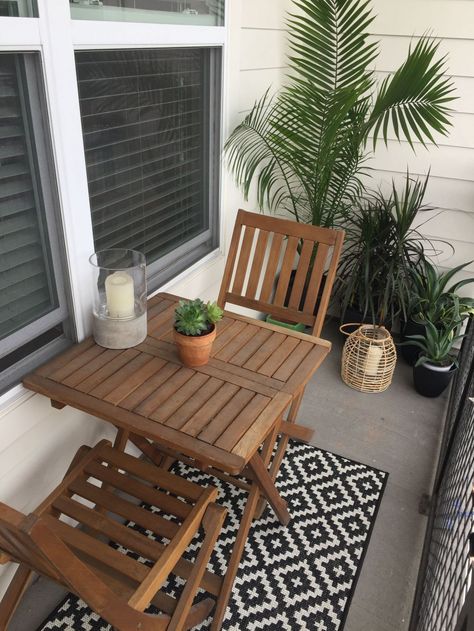
1. Start with the basics: a table and chairs. A small dining set is perfect for morning coffee, intimate dinners, cocktail hour, and quick lunchtime breaks. Go for something small and space-efficient or even furniture that can be folded up and easily leaned or stored.
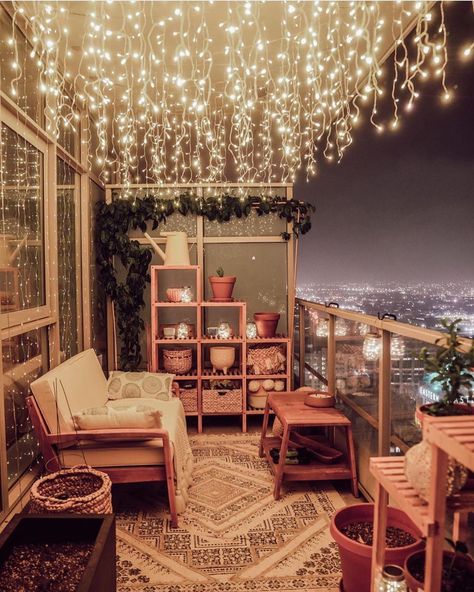
2. Showcase your view. Situate your seating or furniture so as to make the most of your view.

3. Use color. Color is a quick way to add personality and mood to your area. Do you want it to feel festive? Think oranges, reds, and other bright colors (look up “complementary colors” or check out Pinterest for palettes). Or would you rather make the mood quiet and relaxing? — then go with subtler, neutral, or more muted tones. You can always mix it up too, going for a muted palette but with bright accents. Get creative and make it your own!

4. Create a garden. A balcony filled with planters, climbing vines and other foliage creates a lush garden scene. You’ve got a million choices to choose from. Want plants that are fragrant, such as flowering citrus? Or ones that attract hummingbirds and pollinators? Adding herbs (cooking or decorative) will also add some lovely scents. Make sure all pots have saucers to prevent water damage.
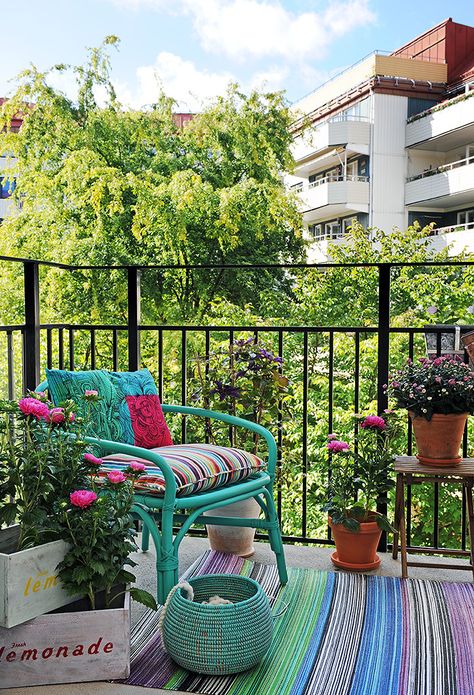
5. Add flowers for instant color appeal. Flowers and blooming plants add a sunny vibe to any balcony. Trailing blooms (think Tuscan verandas) add an extra touch of luxury.

6. Check out floor pillows. If you’re on a tight budget or don’t intend to stay in your rental long, you can still dress up your outside digs. Instead of investing in furniture, look into floor pillows – usually inflatable and outdoor-friendly, these will let you enjoy your place for as long as you’re there.

7. A place to park your drink. Remember to add little side tables or even stools to hold your book, drink, sunglasses, phone, or anything else you’ll want to set down while relaxing outside.

8. Throw down a rug. A patterned rug will open up the space visually and add a decorative dimension. Check out indoor/outdoor options.

9. Make an accent wall. Painting or hanging a decorative piece on the outdoor exterior walls will add a sophisticated design element. This could be an art-type piece, lights, or even a “living wall” add-on of ferns or other plants.
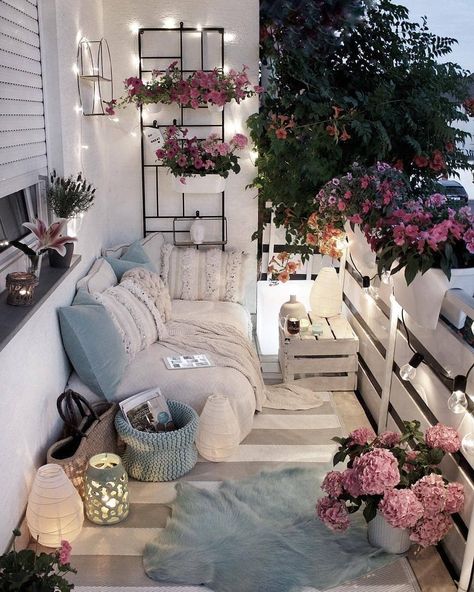
10. Add lighting. Outdoor lights will immediately up-level your balcony and give it evening ambiance. Options include strung lights (for that fairy light effect), LED candles in lanterns, and hanging or standing lights.
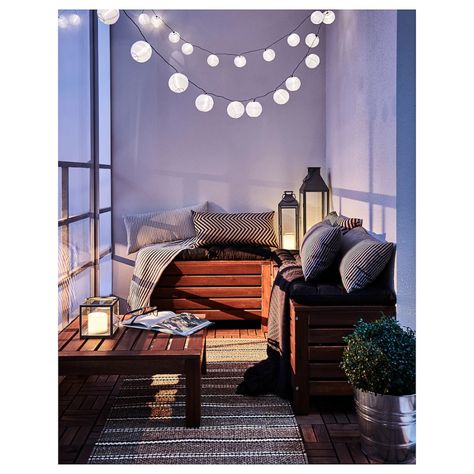
11. Consider bench seating. Bench seating is a bit more of a commitment than moveable chairs. It usually saves space and sometimes doubles as a storage element.
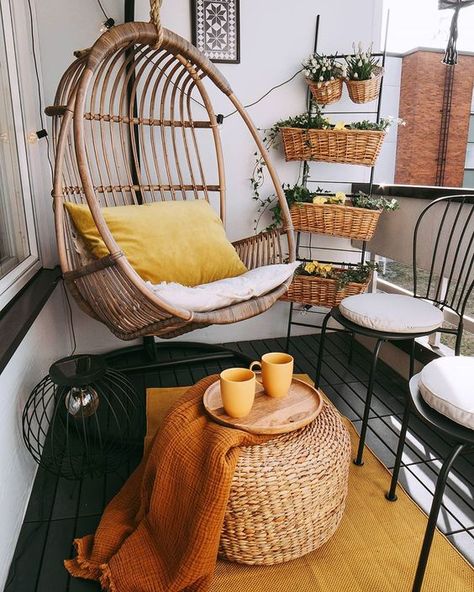
12. Hang a swing or hammock. Lazy swing-time isn’t just for vacation. If you have a lot of space, consider a hammock or swinging bench. This may even nudge you to do more of that self-care relaxing that we all know is so important!

13. Create privacy. Using a room divider or a row of tall bamboo can create a nice illusion of privacy if your balcony directly abuts another.
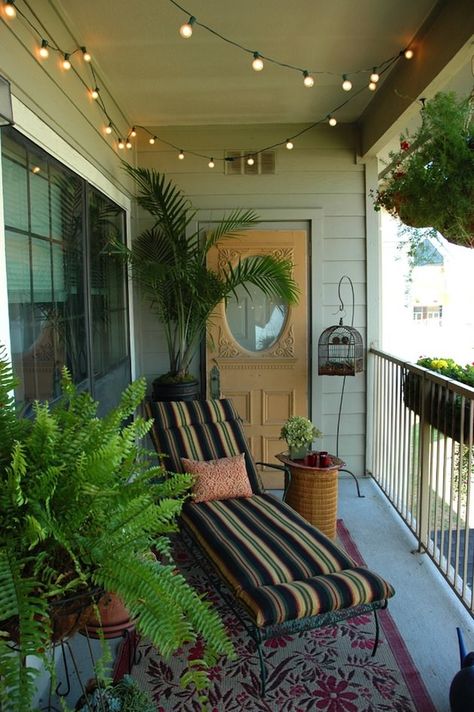
14. Go full recline mode. If space allows, think of getting a lounge chair. Perfect for curling up with a book, working on your laptop, or soaking up the sun, you can make it even comfier with outdoor pillows.

15. Throw shade. If your balcony gets a ton of light (maybe sometimes too much?), look at shading options. This could mean a standing umbrella, shade sail, or a more involved retractable awning.
Before you start on your balcony transformation project, be sure to check in with your roommate and your landlord about anything that might affect your plans. Then design around those and create your own little outdoor oasis – as spring rolls into summer and the warm weather beckons you outside, you’ll be so glad you did!
For more ideas to transform your balcony or outdoor space check out our Pinterest Board “Apartment Balcony Inspiration“
Don’t forget to give us a follow at California Casualty to stay up to date on every fun balcony inspiration we discover! Scan our Pincode with your Pinterest camera to follow:

This article is furnished by California Casualty, providing auto and home insurance to educators, law enforcement officers, firefighters, and nurses. California Casualty does not own any of the photos in this post, all are sources by to their original owners. Get a quote at 1.866.704.8614 or www.calcas.com.
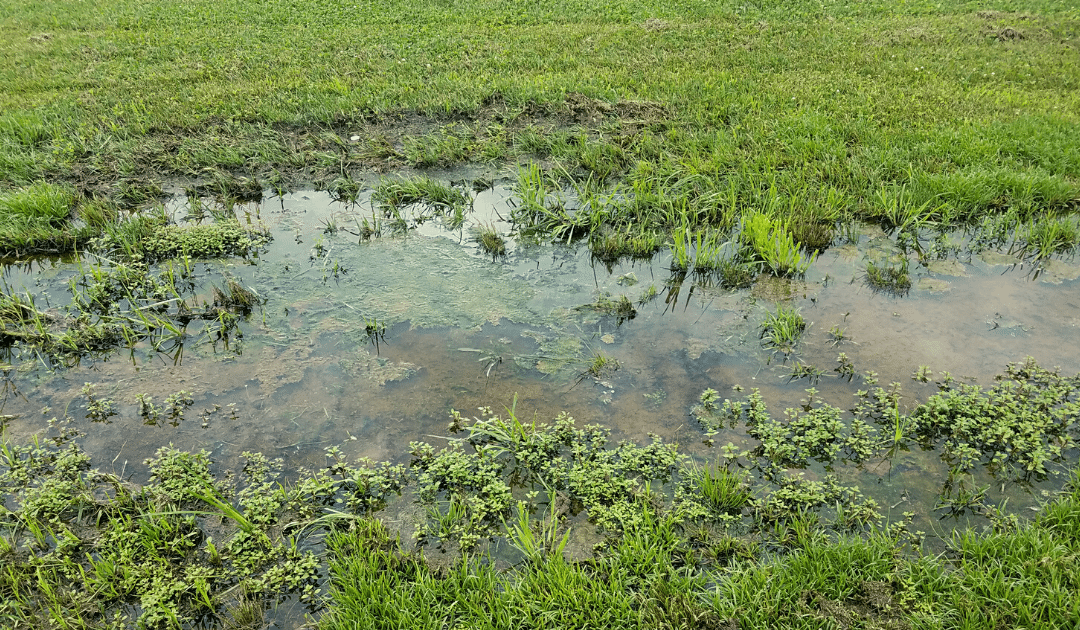
by California Casualty | Calcas Connection, Good to Know, Homeowners Insurance Info |
Spring is here! And so are spring storms, but spring showers don’t just bring flowers, they can also bring more water than what your yard can hold. And this standing water around your house can cause water damage to your home- costing you more than you think.
By definition, standing water is a body of water that does not move or sink into the ground. It can be caused by a number of factors: heavy rain, over-watering, poorly draining soil, improper grading, incorrect landscaping, low areas in your yard, and even water line leaks or bursts.
If you have standing water in your yard for multiple days, it can cause serious damage to your home. Not only will it be an eyesore that can ruin your grass and draw unwanted bugs, but stagnant water on the side of your home can also seep into small cracks or pores in your home’s foundation and get into your crawl space or basement, which can lead to water damage & more.
Here’s why you should address the standing water near your home now, and how you can prevent it from happening in the future.
Standing Water Can…
Ruin your basement. Water can cause cracks in your home’s foundation. This is how water enters your basement or your crawl space. Once inside it can create a musty odor and add dampness that will completely ruin flooring, drywall, furniture, electronics, etc.
Produce mold & mildew. High levels of condensation and humidity inside of your basement or crawl space create an environment for mold and mildew to thrive. This could not only affect your home, but it could also cause major health issues for you and your family.
Breakdown your home’s foundation. Over time, standing water that has made its way into your cement foundation will start to cause shifting and bowing of your structure. This is the beginning of the breakdown of your home’s foundation. If not taken care of- doors will no longer close, floorboards will start to squeak, steel beams may have to be inserted, and it could even lead to structural collapse.
Cost you thousands of dollars in repairs. A homeowner spends over $3,000 on average to repair damages to their home and property caused by water. Preventive maintenance and early detection are key to helping you save your home and your wallet.
But that’s not all, standing water can also draw unwanted pests: mosquitoes, roaches, termites, ants, silverfish, and other pests thrive in moist environments. They will seek damp areas and make your home their home if you don’t address the issue quickly.
Here’s how you can prevent standing water from getting into your home this spring.
How to Prevent Standing Water
1. Check for Proper Roof Drainage
Make sure every drop of rain will drain off of your roof correctly- starting at your gutters. Make sure they are free of leaves and sticks and that you have an attached downspout that is also clear of debris. It is also important to make sure your downspout has a downspout extension that will move water away from the foundation of your home.
2. Monitor Your Sprinkler Usage
If you see standing water, make sure to check that your sprinklers are not overwatering your lawn. First, check to make sure the sprinkler heads are functioning properly and not broken. If there is no issue, you will likely just need to reset your sprinklers to run at a less-frequent timespan. After resetting, if you are still seeing patches of barren or muddy lawn, you may have a leaky valve. Valves are responsible for distributing the water throughout the entire system, and if damaged they will need to be replaced right away.
3. Make Sure Your Yard is Correctly Graded
Grading, also referred to as lawn leveling, is the process of leveling your lawn to allow for the proper drainage of water. If you have water that is pooling around your foundation or your house is sitting on a low level, you may need to look into re-leveling your yard. Grading involves the moving of topsoil onto the yard. You will then even out the low spots with the soil and form a downward slope (around 2%) from your home’s foundation. Leveling is an intricate process, and if your yard needs re-leveled, you may need to hire a professional.
4. Aerate Your Lawn
Aerating your yard means to perforate the soil with holes (4 – 6 inches deep) to allow water, air, and other nutrients to better absorb into the soil. Not only will aeration lead to a greener, healthier lawn, but it will also alleviate soil compaction and allow water to better absorb during rainstorms. The best time to aerate your lawn is during spring and fall.
5. Mind Your Landscaping
Improper landscaping can cause water to sit at the base of your home’s foundation and ultimately make it into your home. When landscaping, avoid making any changes that will block drains or downspouts. Make sure that all of your landscaping slopes downward to create runoff and that all downspout extensions or drainage systems extend beyond your planting beds leading the water away and far from your foundation.
6. Install a Drainage System
If you are constantly struggling with standing water in an area of your yard, it may be best to look into installing a yard drain. Yard drains act like shower drains. They prevent flooding and move the water away from your yard through hidden pipes to a dry well. The dry well will then collect the water underground and slowly percolate to the soil around it
Standing water is a serious, yet largely overlooked, issue that can have serious consequences. If water has been in your yard for multiple days and won’t drain, don’t neglect it. Look for the cause of your problem or reach out to a professional. Acting today will save you time, money, and headache tomorrow.
This article is furnished by California Casualty, providing auto and home insurance to educators, law enforcement officers, firefighters, and nurses. Get a quote at 1.866.704.8614 or www.calcas.com.
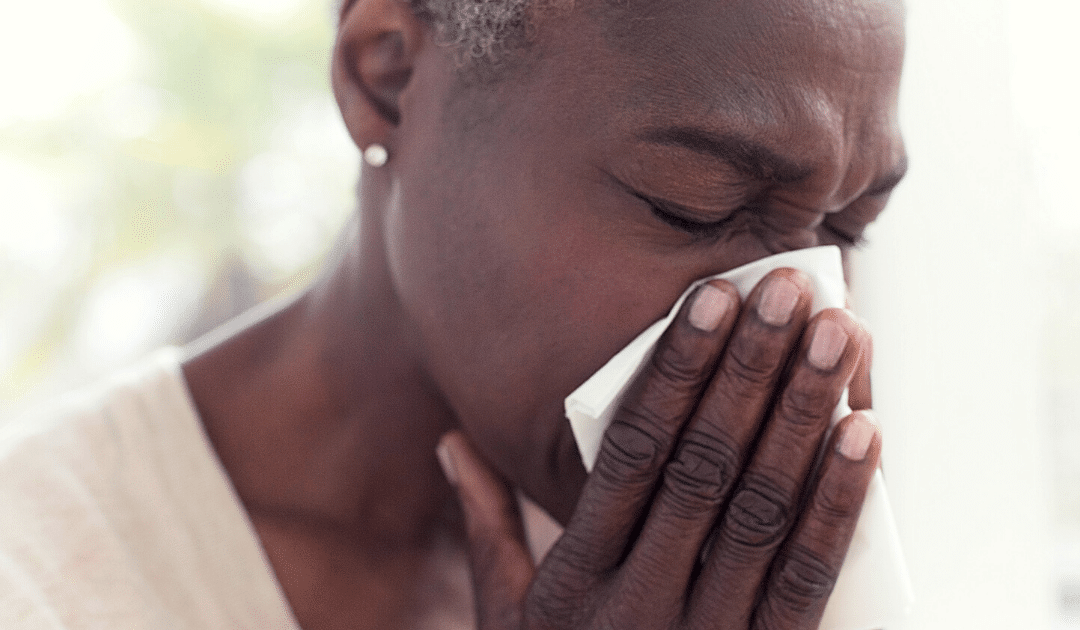
by California Casualty | Homeowners Insurance Info |
As the weather warms up, seasonal allergies can collide with everyday household allergens to create the perfect storm of misery for allergy sufferers. If you or your family members are allergy-prone, there are steps you can take to minimize allergens throughout your home and throughout pollen season.
These 11 tips can help vastly improve your home’s indoor air quality, helping prevent asthma flare-ups, new cases of mold allergies, and the need for bulk purchases of tissues and antihistamines!
- Clean well, clean often. A clean house is a healthier house. Regular, thorough cleaning of all surfaces and furnishings will keep allergen counts down, prevent mold and decrease pet dander. Besides the regular surfaces, keep in mind too that clearing out clutter is a big factor in controlling dust. One more reason to get rid of extra stuff!
- Vacuum regularly. Consistent vacuuming is a powerful weapon in removing allergens, toxins, mold spores, mites, and other offenders. Depending on your household’s activity levels and allergy sensitivity, you may need to vacuum as often as every other day or so. Use a HEPA filter in your vacuum and change it often.
- Control dust mites. These critters thrive in bedding and linens that aren’t cleaned often enough. Keep them in check by washing bedding, uncovered pillows, and kids’ stuffed toys in hot water each week, and dry with high heat. Zippered allergen-resistant covers for mattresses, pillows, and box springs are especially effective against allergy attacks. Avoiding heavy drapes, wall-to-wall carpet and overstuffed fabric furniture also control mites, as does humidity-regulating air-conditioning.
- Limit indoor greenery. House plants add beauty, but many times they can harbor mold. Try to cull out all but your favorites, and for the plants you do keep, lay down aquarium gravel on top of the soil to discourage mold growth.
- Get an air filter or purifier. Air cleaning devices can significantly improve indoor air quality (if you’re on the west coast, these are a lifesaver during wildfire season). Go for high-quality air filters such as HEPA or certified asthma/allergy ones. Choose from stand-alone filters or those designed to be installed in your central air system – or better yet, both!
- Stay ahead of pet dander. Keeping up with a vacuuming and cleaning schedule will help limit dander. You can also cover vents with material such as cheesecloth to catch circulating dander. Regularly wash and dry pet beds and toys. Bathe pets weekly and wear a mask when grooming them. And finally, if you’re able to resist the puppy-dog eyes, try not to let pets sleep in bedrooms.
- Keep pollen out. Keep doors and windows closed and use the air conditioning to keep pollen, dust, and other toxins outside. Change air filters frequently, especially during pollen season.
- Prevent mold. Damp areas breed mold spores, which then travel throughout your home. Reduce moisture in the bathroom by running a fan during and after showers, minimizing shower time, and making sure wet clothes, towels, and bathing suits are hung or dried. To further limit the spread of mold, use dehumidifiers and/or air conditioning, use humidity monitors if needed, limit the number of houseplants and fix all leaks.
- Control pests. Prevent cockroaches and mice with traps or hire a professional exterminator. Repel them in the first place by always putting garbage, food waste, and recycling into containers with an insect-proof lid and emptying bins daily. Keep the kitchen free of crumbs and food scraps. Store pet food in sealed containers. Seal cracks and other possible pest entryways.
- Dehumidify. Use a dehumidifier in especially damp areas such as the basement.
- Adopt a no-smoking policy. Do not allow smoking inside your home. Besides a range of serious health effects, tobacco smoke can also cause asthma – not just for the smoker but for anyone exposed to secondhand smoke.
The bad news about allergies? They will always be around us. The good news? We can do something about them! A thorough spring cleaning can get you on the right track (not sure where to start? – check out our tips here!). After that, consistently following the 11 steps above will help reduce allergens and improve your indoor air quality all year round – which will in turn keep you and your family healthier and safer for years to come.
This article is furnished by California Casualty, providing auto and home insurance to educators, law enforcement officers, firefighters, and nurses. Get a quote at 1.866.704.8614 or www.calcas.com.
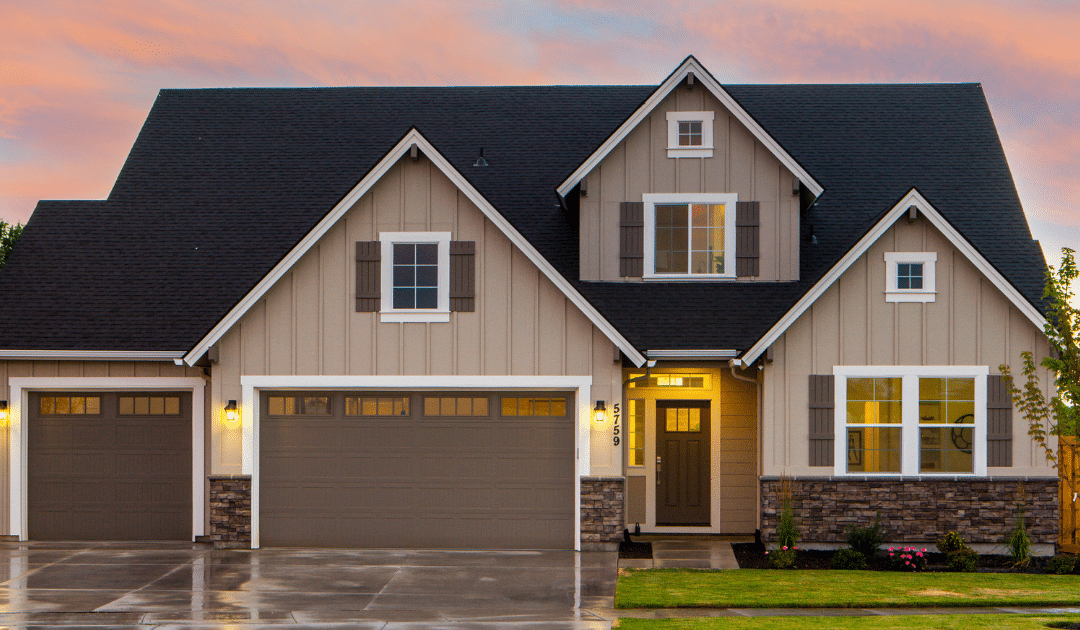
by California Casualty | Calcas Connection, Homeowners Insurance Info |
The real estate market is usually deemed “hot” when inventory is low and competition is high. Hot markets often mean quick turnover, crowded open houses, bidding wars, and sales that close above asking (and sometimes all in cash). To the surprise of many, we’ve been in a hot market nationwide throughout the pandemic, and there are few signs it’s cooling down.
If you’re planning to buy (or sell!) soon, you’ll want to position yourself well by doing some extra prep work and research than you would in a neutral market. That way, you’ll be able to make smart decisions fast and strike when you see the right opportunity. Follow these pointers to come out ahead.
For buyers and sellers
-
- Get a good agent – An experienced agent who knows your local market will be worth their weight in gold. If you’re a buyer, they should know about listings before they come on the market and know how to make your offer stand out. Ask for referrals from your network and social circles.
- Be patient – Especially for buyers, patience is a virtue in a hot market, when you can make many offers before your winning one is accepted. Try not to get discouraged – rather, stay focused on your goal! And if you’re a seller, patience will help you find the right buyer.
- Know what’s going on in your local market – Your agent will know what market trends and events mean for your goals and priorities, but it’s smart to follow the market movements yourself too.
- Don’t get emotional – Letting emotions influence the buying or selling process can lead to bad or regretful decisions. Practice mindfulness or other techniques to stay grounded in those stressful moments of the journey. It’s good to have some thresholds and decisions made ahead of time so you have some “guardrails” at the ready.
- Have your paperwork ready – Whatever papers and documents you’ll need for the process, get as many of them ready as possible beforehand. That way, you won’t lose precious time when the clock is ticking.
- Be ready to move quickly – Speed is the name of the game in hot markets. Things can change overnight, and the perfect opportunity might present itself out of nowhere. When the conditions meet your pre-determined criteria, move quickly.
- Keep your insurance until you close – Don’t make changes to your insurance or cancel it prematurely – no matter how sure a deal seems.
If you’re a buyer
-
- Be very clear on your budget. The absolute first step is to know how much home you can afford. Knowing your range is good too but be sure you know where your ceiling is – and stick to it once you start putting in offers.
- Know your must-haves and where you can be flexible. Have a clear understanding ahead of time what attributes your new home must have and what things can be changed, renovated, or aren’t all that important in the grand scheme of things.
- Window shop – Get a handle on the local market by touring homes that would be in your price range and meet your requirements. This way, you’ll gain a sixth sense and sharp instincts for when you start making offers.
- Get financing and a pre-approval letter. Make sure your financing is lined up and you have a pre-approval letter. You’ll want to go with a lender that delivers on their promises and has a track record of closing loans quickly.
- Leverage your agent. Your agent has ways to make you stand out from the rest of the bidders. For instance, they can find out what the seller wants by calling the listing agent or gleaning information from the multiple listings service (MLS), which has more information than public listings.
- Read our guide. If you haven’t already, check out our top tips for your home-buying journey (good for any market, including hot markets!)
If you’re a seller
-
- Prep your property. Sellers in a hot market will have more luck selling their home “as is,” but it can pay off to make any needed fixes before listing. This will help you attract more interest and multiple offers (which usually means a better sale price in the end).
- Consider staging. Staging is probably one of the best ways to position your property to sell quickly and at a good price. It puts your home in its best possible light and gives potential buyers a great first impression and good feeling in the space. It will also differentiate your property from others.
- Get the “pre-work” done. Go over what you might need with your agent ahead of time. They might suggest getting an inspection done before listing, lining up a title company, and other due diligence items.
- Manage your expectations. A hot market doesn’t guarantee that you’ll get multiple offers over asking. Each sale is the product of lots of different variables, which is why it’s worth taking extra steps to give your property every advantage.
With the right tools, knowledge, and strategies, you can do well in a hot market. Above all, remember to get a good agent, have patience and get the prep work done before hitting “GO.” Good luck!
This article is furnished by California Casualty, providing auto and home insurance to educators, law enforcement officers, firefighters, and nurses. Get a quote at 1.866.704.8614 or www.calcas.com.
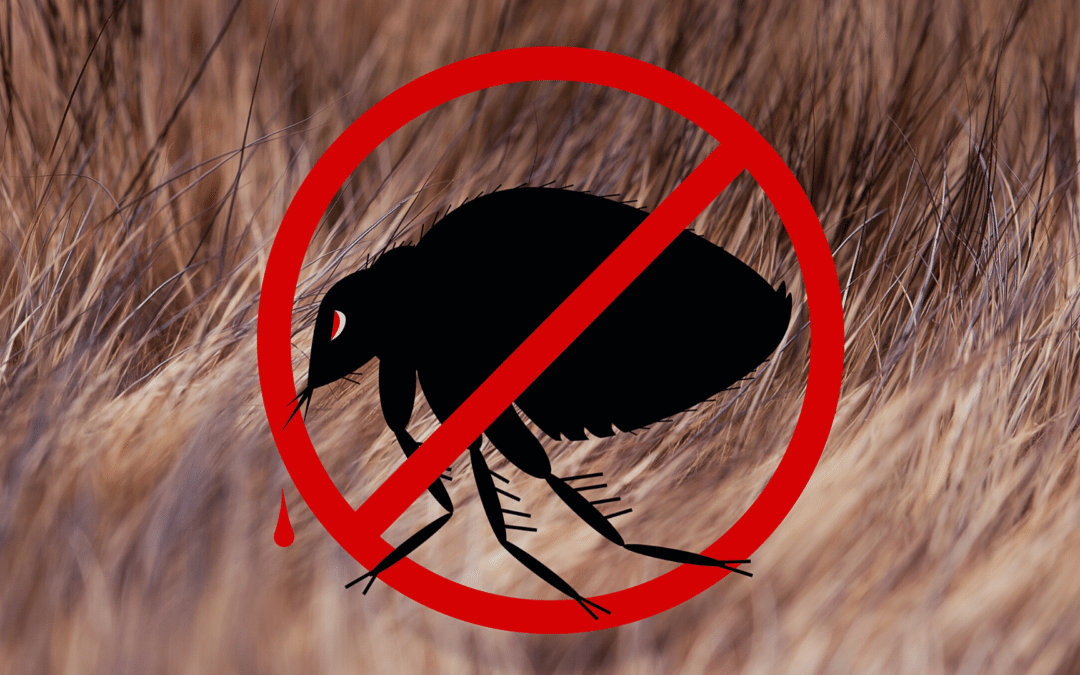
by California Casualty | Homeowners Insurance Info, Pets |
The new blooms and foliage that herald the beginning of spring also bring one of its worst offenders: fleas and ticks. A headache for pet owners every year, keeping these pests in check requires a three-pronged approach focusing on your pet(s), your house, and the natural space around your home. Use the strategies below to prevent misery for your pets and an infestation inside your home.

Protecting your pet takes a little research, communication with your vet, and a disciplined care and grooming routine.
-
- Talk to your vet and go with the flea and tick control product they think is best for your pet. There are lots of options, including topical treatments, pills, shampoos, and collars. If you live someplace with lots of sunny and/or humid days, also ask about sun + bug repellant products.
- For dog or cat? Double-check with your vet – or if buying off the shelf, read the label – to make sure the product is meant for the pet you’re buying it for. Some products are made only for canines or felines and others can be used on either (but require different dosages).
- Do a daily flea/tick check, especially during the height of the season or if your pet’s been in or around grasses, shrubs, and bushes.
- Groom them regularly and use a flea comb. Check for flea feces and dried blood, which tells you there’s a problem.
- If you have more than one dog, treat them all at the same time so they’re on the same schedule – and your life’s made a little easier!
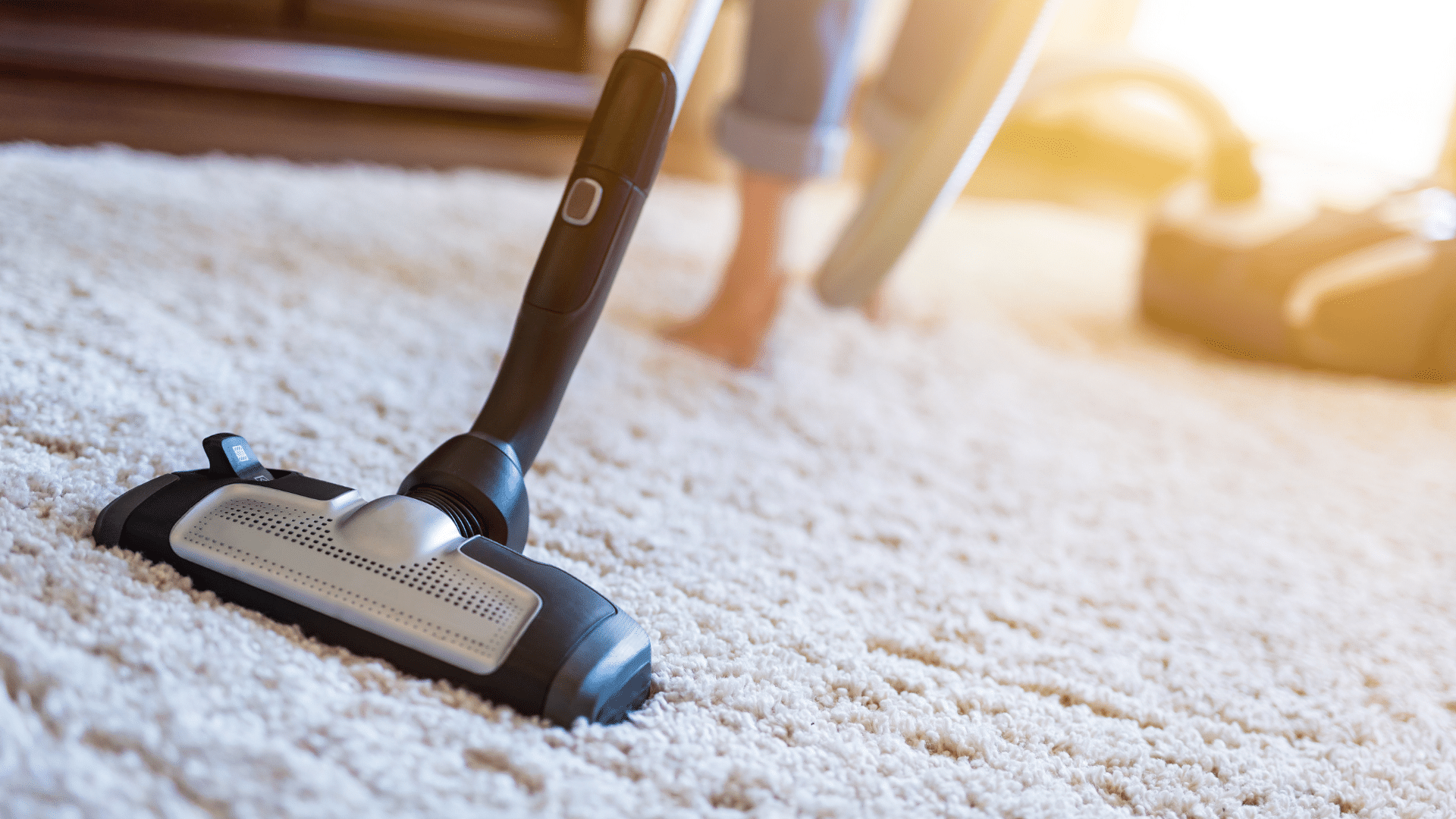
Protect Your Home
To avoid the nightmare scenario of flea shampooing your carpets or fumigating your home, prevent the bugs from getting comfy in your house (or getting in in the first place).
-
- Regularly wash all animal beds and soft toys on hot water and heat dry.
- Vacuum at least weekly to get rid of or prevent eggs, larvae, and adults. Be sure to hit sofas and carpets as well as crevices at the walls and baseboards. If you’re seeing an uptick (pun intended!) in pest sightings, vacuum daily instead of weekly – then empty the vacuum outside.
- Keep pets indoors more often, especially when ticks and fleas are really bad. Going in and out multiple times a day increases the chances they’ll bring bugs home. Walking on a leash and away from grasses is fine to get them exercise without exposing them too much.
- Trim trees and high shrubs that might provide a pathway for rodents and other critters to crawl into your attic. Wherever there are critters, there are fleas and ticks. Spring trimming keeps this to a minimum.
- Seal off any openings to the garage, basement, attic, sheds, or under decks where pests might nest and attract bugs.
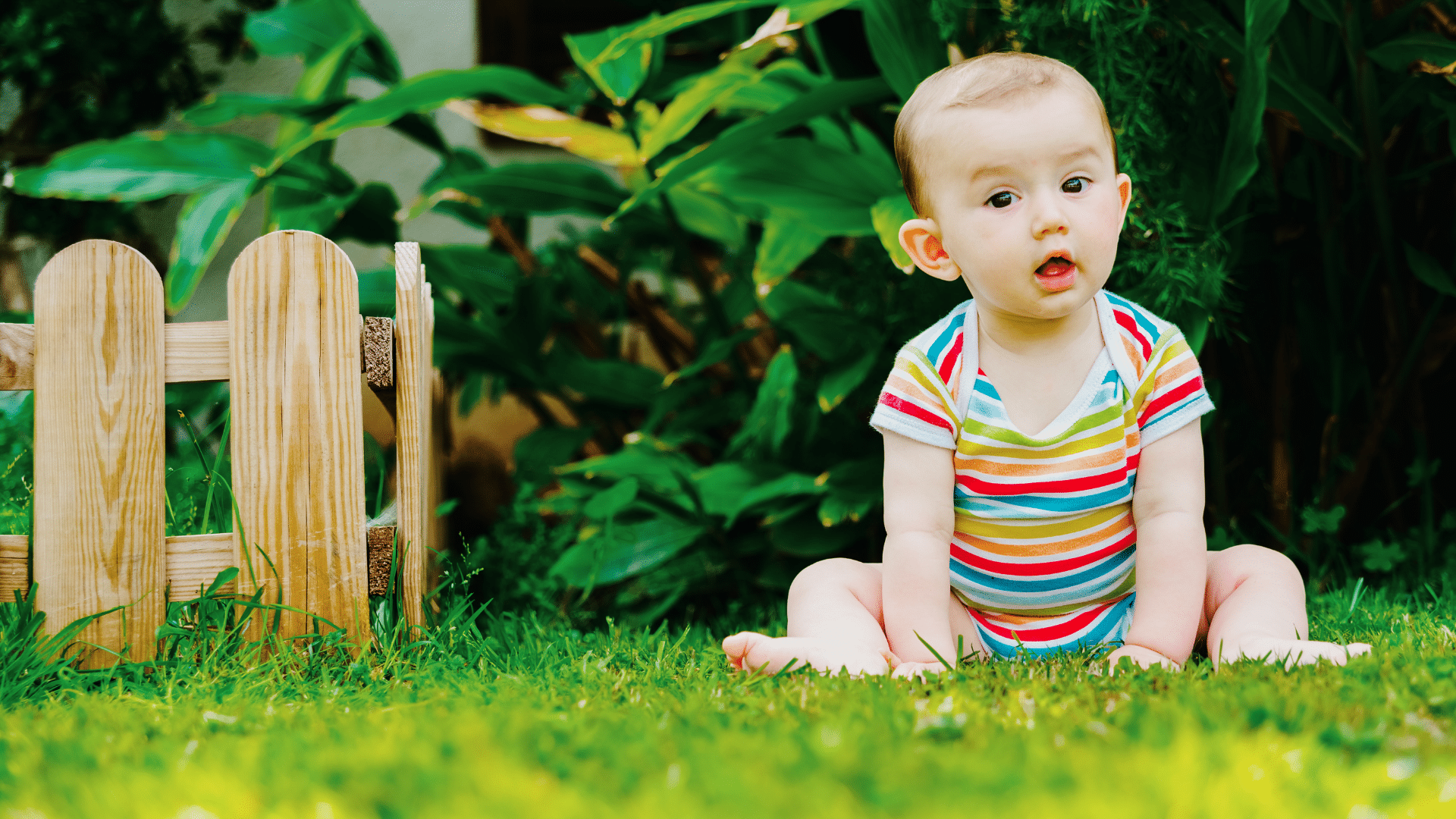
Protect Your Yard
A few smart actions in your front and back yards can significantly limit the bugs that get on your pets or make it into your home.
-
- Keep your lawn mowed and grass/weeds as short as possible.
- Rake up and compost leaves near your home so as to reduce leaf litter that bugs breed in. If you have acreage, try to leave the litter beyond a safe perimeter so that migrating or local birds have access to food (i.e. – the bugs that make home in the leaf litter).
- Maintain a perimeter of gravel or woodchips 3 feet from the house.
- Stack firewood in a dry area so that rodents – and hitchhiking fleas and ticks – are kept in check.
- Remove any old furniture, debris, or other trash that provides nesting spots for bugs.
- Try tick control tubes. These hold permethrin-treated cotton, and the idea is that mice steal the cotton to make nests – which then kill the fleas.
- Consider a spray as last resort for your yard. However, do your research as many sprays will kill pollinators and all add chemicals to your yard. Go for something natural if possible and use it in conjunction with prevention measures.
The three-pronged approach above should keep your pets pest-free and your home healthy and safe. A little extra attention to prevention measures goes a long way toward a relaxing, beautiful springtime.
This article is furnished by California Casualty, providing auto and home insurance to educators, law enforcement officers, firefighters, and nurses. Get a quote at 1.866.704.8614 or www.calcas.com.
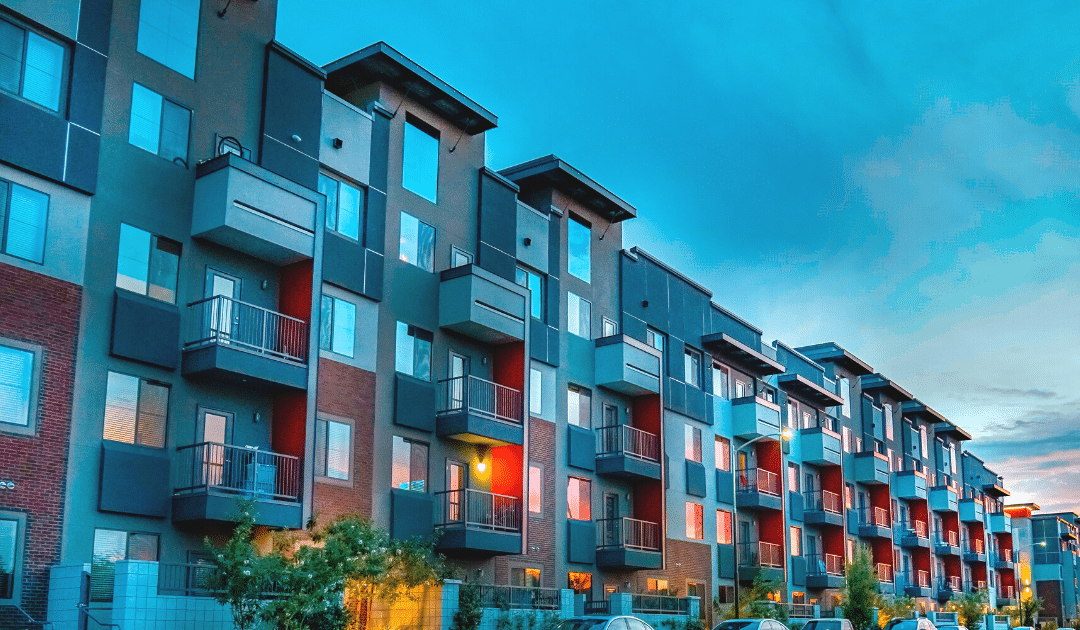
by California Casualty | Homeowners Insurance Info |
Millions of Americans choose to rent over buying homes and apartments each year, and there are a ton of advantages. For instance, if a window starts leaking or the stove dies, you don’t have to pay for repairs or replacements. You have the flexibility to move when you want (subject to your lease), “try out” new cities, and avoid the big costs that go along with mortgage loans and homeownership.
To be a good tenant and start your rental out on the right foot, here are some important renter do’s and don’ts.

Do’s
Understand your lease – Make sure you and your landlord review the lease together and that you ask any questions you have. For example, does the lease allow subletters? What’s the duration and does it change after the first year?
Write an inventory – Make sure to document and log all existing damage or broken/non-functional items before you officially move in. Take photos and indicate any damage on a floor layout/ diagram. You don’t want to be on the hook for these repairs when you move out.
Understand your responsibilities – As the tenant, you may be required to do things like shovel the walk, keep the lawn mowed or hire a pool service.
Document problems – If there are ongoing issues or needed repairs, make sure you write down what happened, take pictures, etc. Alert your landlord to issues right away so they can take action. Keep a paper trail and keep it all in one place.
Keep it clean – Neglecting to bring the garbage bins in from the sidewalk or to keep the yard clean or tidy can quickly create an enticing environment for pests and rodents.
Check-in with your landlord – For minor repairs or maintenance, such as unclogging drains or replacing caulk or window screens, it’s best to check in with your landlord about how they want to address it (even if you’d like to just take care of it yourself). if you are unsure of anything or have questions regarding the property, like painting rooms or changing landscaping, reach out to your landlord.
Give them a heads up – On things like leaks, structural or foundation issues, and pest problems, alert your landlord as soon as possible so they can act on a problem that could get worse quickly or cause costly damage.
Protect your deposit – Besides treating your place well while you live there, when you move out, do a quality deep clean and don’t leave furniture or anything else behind that they’ll need to deal with.
Be a good communicator (and neighbor) – Good communications can prevent or de-escalate miscommunications and disagreements with your landlord as well as neighbors.
Know your rights – It’s important to know your rights as a tenant. They vary by state and city, so go here to learn more.
Get renters insurance – Renters insurance protects your belongings from theft and damage (nope, your landlord’s insurance won’t cover your things). It’s surprisingly affordable – get a quote today.
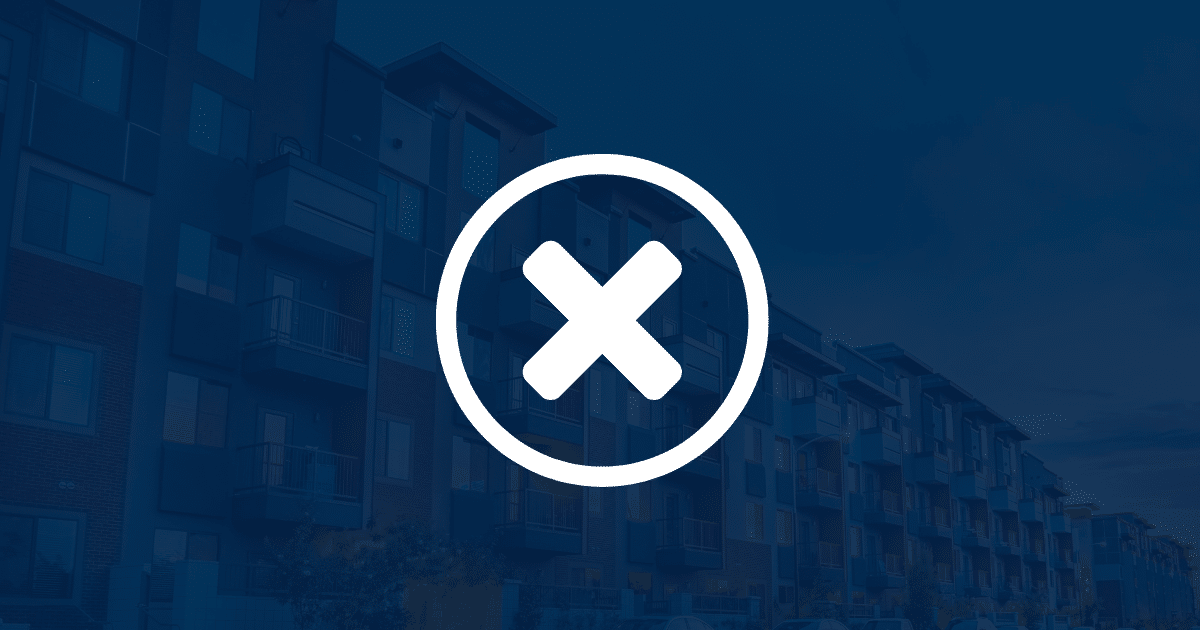
Don’ts
Hide a pet – If your lease specifies no pets, stick to the agreement (hiding a pet won’t work over the long term). Also make sure to adhere to animal weight limits, which are often established to allow only cats and small dogs in an apartment complex. Consequences for breaking these rules can include a hefty fine or even lease dismissal.
Undertake big renovations – We all want to make our homes more home-y, but complex projects such as adding ceiling fans or replacing cabinetry should only be undertaken by the property owner.
Fall behind on the bills – Depending on your lease agreement, you may end up being responsible for bills such as utilities, water, garbage, recycling, gardener, pest control or pool maintenance. Keeping those accounts current will ensure smooth maintenance as well as strengthen your credit.
Create a mildew problem – One of landlords’ most frequent complaints is about tenants not keeping moisture levels in check. To prevent mold and mildew formation, make sure to use vents and fans in bathrooms during (and after) every shower.
Cause damage – Treating your rental with care and respect will mean lessening the chances of inflicting damage such as stained carpets, scratches in hardwood, broken windows or fixtures, large holes in the walls, and water damage from plants. It will also ensure you get more (if not all) of your security deposit back. If accidental damage does occur (we’re only human, after all), make your landlord aware of it ASAP.
Landlords choose their tenants very carefully – especially those with nice properties. By taking care of your rental home and maintaining a good relationship with your landlord, you will set yourself apart as a responsible tenant. This will positively affect your credit score, help you get your whole security deposit back, and ensure you have a good reference for that next great rental.
This article is furnished by California Casualty, providing auto and home insurance to educators, law enforcement officers, firefighters, and nurses. Get a quote at 1.866.704.8614 or www.calcas.com.



























